Geochemistry, Geochronology, and Hf-S-Pb Isotopes of the Akechukesai IV Mafic-Ultramafic Complex, Western China
Abstract
:1. Introduction
2. Geological Setting
3. Geology of the Akechukesai IV Complex
4. Analytical Methods
5. Analytical Results
5.1. Major- and Trace-Element Compositions
5.2. Zircon U–Pb Ages and Hf Isotopic Data
5.3. Sulfur and Lead Isotopic Data for Sulfides
6. Discussion
6.1. Crustal and Source Contamination
6.2. Mantle Source Affinities
6.3. Geodynamic Implications
7. Conclusions
Author Contributions
Funding
Acknowledgments
Conflicts of Interest
References
- Meng, F.C.; Cui, M.H.; Wu, X.K.; Ren, Y.F. Heishan mafic–ultramafic rocks in the Qimantag area of Eastern Kunlun, NW China: Remnants of an early Paleozoic incipient island arc. Gondwana Res. 2015, 27, 745–759. [Google Scholar] [CrossRef]
- Yuan, C.; Zhou, M.F.; Sun, M.; Zhao, Y.J.; Wilde, S.; Long, X.P.; Yan, D.P. Triassic granitoids in the eastern Songpan Ganzi Fold Belt, SW China, Magmatic response to geodynamics of the deep Lithosphere. Earth Planet. Sci. Lett. 2010, 290, 481–491. [Google Scholar] [CrossRef]
- Xu, Z.Q.; Yang, J.S.; Li, H.B.; Zhang, J.X.; Wu, C.L. Terrane Amalgamation, Collision and Uplift in the Qinghai-Tibet Plateau; Geological Publishing House: Beijing, China, 2007; pp. 1–458. [Google Scholar]
- Li, X.W.; Huang, X.F.; Luo, M.F.; Dong, G.C.; Mo, X.X. Petrogenesis and geodynamic implications of the Mid-Triassic lavas from East Kunlun, northern Tibetan Plateau. J. Asian Earth Sci. 2015, 105, 32–47. [Google Scholar] [CrossRef]
- Xiong, F.H.; Ma, C.Q.; Wu, L.; Jiang, H.A.; Liu, B. Geochemistry, zircon U–Pb ages and Sr–Nd–Hf isotopes of an Ordovician appinitic pluton in the East Kunlun orogen: New evidence for Proto-Tethyan subduction. J. Asian Earth Sci. 2015, 111, 681–697. [Google Scholar] [CrossRef]
- Li, C.S.; Zhang, Z.W.; Li, W.Y.; Wang, Y.L.; Sun, T.; Ripley, E.D. Geochronology, petrology and Hf–S isotope geochemistry of the newly-discovered Xiarihamu magmatic Ni–Cu sulfide deposit in the Qinghai–Tibet plateau, western China. Lithos 2015, 216–217, 224–240. [Google Scholar] [CrossRef]
- Peng, B.; Sun, F.Y.; Li, B.L.; Wang, G.; Li, S.J.; Zhao, T.F.; Li, L.; Zhi, Y.B. The geochemistry and geochronology of the Xiarihamu II mafic-ultramafic complex, Eastern Kunlun, Qinghai Province, China: Implications for the genesis of magmatic Ni-Cu sulfide deposits. Ore Geol. Rev. 2016, 73, 13–28. [Google Scholar] [CrossRef]
- Shao, F.L.; Niu, Y.L.; Liu, Y.; Chen, S.; Kong, J.J.; Duan, M. Petrogenesis of Triassic granitoids in the East Kunlun Orogenic Belt, northern Tibetan Plateau and their tectonic implications. Lithos 2017, 282–283, 33–44. [Google Scholar] [CrossRef]
- Xin, W.; Sun, F.Y.; Li, L.; Yan, J.M.; Zhang, Y.T.; Wang, Y.C.; Shen, T.S.; Yang, Y.J. The Wulonggou metaluminous A2-type granites in the Eastern Kunlun Orogenic Belt, NW China: Rejuvenation of subduction-related felsic crust and implications for post-collision extension. Lithos 2018, 312–313, 108–127. [Google Scholar] [CrossRef]
- Jiang, C.Y.; Ling, J.; Zhou, W.; Du, W.; Wang, Z.; Fan, Y.; Song, Y.; Song, Z. Petrogenesis of the Xiarihamu Nibearing layered mafic-ultramafic intrusion, East Kunlun: Implications for its extensional island arc environment. Acta Petrol. Sin. 2015, 31, 1117–1136. [Google Scholar]
- Song, X.Y.; Yi, J.N.; Chen, L.M.; She, Y.W.; Liu, C.Z.; Dang, X.Y.; Yang, Q.A.; Wu, S.K. The Giant Xiarihamu Ni-Co sulfide deposit in the East Kunlun Orogenic Belt, Northern Tibet Plateau.China. Econ. Geol. 2016, 111, 29–55. [Google Scholar] [CrossRef]
- Sun, F.Y.; Chen, G.H.; Chi, Q.G. Report of Metallogenic Regularity and Prospecting Direction Comprehensive Study in Xinjiang–East Kunlun Metallogenic Belt; China Geological Survey: Beijing, China, 2003. (In Chinese) [Google Scholar]
- Wang, G.C.; Wang, Q.H.; Ping, J.; Zhu, Y.H. Zircon SHRIMP ages of Precambrian metamorphic basement rocks and their tectonic significance in the Eastern Kunlun Mountains, Qinghai province, China. Earth Sci. Front. 2004, 11, 481–490. (In Chinese) [Google Scholar]
- Yuan, H.L.; Gao, S.; Liu, X.M.; Li, H.M.; Gunther, D.; Wu, F.Y. Accurate U–Pb age and trace element determinations of zircon by laser ablation—inductively coupled plasma mass spectrometry. Geostand. Newslett. 2004, 28, 353–370. [Google Scholar] [CrossRef]
- Andersen, T. Correction of common lead in U–Pb analyses that do not report 204Pb. Chem. Geol. 2002, 192, 59–79. [Google Scholar]
- Liu, Y.S.; Hu, Z.C.; Gao, S.; Günther, D.; Xu, J.; Gao, C.G.; Chen, H.H. In situ analysis of major and trace elements of anhydrous minerals by LA-ICP-MS without applying an internal standard Chem. Geol. 2008, 257, 34–43. [Google Scholar] [CrossRef]
- Ludwig, K.R. User’s Manual for Isoplot/Ex v30, a Geochronology Toolkit for Microsoft Excel; Berkeley Geochronological Center Special Publications: Berkeley, CA, USA, 2003; Volume 4, pp. 25–31. [Google Scholar]
- Blichert-Toft, J.; Albarède, F. The Lu–Hf geochemistry of chondrites and the evolution of the mantle–crust system. Earth Planet. Sci. Lett. 1997, 148, 243–258. [Google Scholar] [CrossRef]
- Wu, F.Y.; Yang, Y.H.; Xie, L.W.; Yang, J.H.; Xu, P. Hf isotopic compositions of the standard zircons and baddeleyites used in U-Pb geochronology. Chem. Geology 2006, 234, 105–126. [Google Scholar] [CrossRef]
- Guo, C.L.; Chen, Y.C.; Zeng, Z.L.; Lou, F.S. Petrogenesis of the Xihuashan granites in southeastern China: Constraints from geochemistry and in-situ analysis of zircon U-Pb-Hf-O isotopes. Lithos 2012, 148, 209–227. [Google Scholar] [CrossRef]
- Boynton, W.V. Geochemistry of the rare earth elements: Meteorites studies. In Rare Earth Element Geochemistry; Henderson, P., Ed.; Elservier: Amsterdam, The Netherlands, 1984; pp. 63–114. [Google Scholar]
- McDonough, W.F.; Sun, S.S. The composition of the earth. Chemical Geology 1995, 120, 223–253. [Google Scholar] [CrossRef]
- Wu, F.Y.; Li, X.H.; Zheng, Y.F.; Gao, S. Lu-Hf isotopic systematics and their applications in petrology. Acta Petrological Sinica 2007, 23, 185–220. [Google Scholar]
- Zartman, R.E.; Doe, B.R. Plumbo tectonics- the model. Tectonophysics 1981, 75, 135–162. [Google Scholar] [CrossRef]
- Jochum, K.P.; Seufert, H.M.; Spettel, B.; Palme, H. The solar-system abundances of Nb, Ta and Y, and the relative abundances of refractory lithophile elements in differentiated planetary bodies. Geochim. Cosmochim. Acta. 1986, 50, 1173–1183. [Google Scholar] [CrossRef]
- Zindler, A.; Hart, S.R. Chemical geodynamics: Annu al Rev. Earth Planet Sci. 1986, 14, 493–571. [Google Scholar] [CrossRef]
- Tang, D.M.; Qin, K.Z.; Sun, H.; Su, B.X.; Xiao, Q.H. The role of crustal contamination in the formation of Ni-Cu sulfide deposits in Eastern Tianshan, Xinjiang, Northwest China: Evidence from trace element geochemistry, Re-Os, Sr-Nd, zircon Hf-O, and sulfur isotopes. J. Asian Earth Sci. 2012, 49, 145–160. [Google Scholar] [CrossRef]
- Hofmann, A.W. Chemical differentiation of the earth: The relationship between mantle, continental crust, and oceanic crust. Earth Planet. Sci. Lett 1988, 90, 297–314. [Google Scholar] [CrossRef]
- Brenan, J.M.; Shaw, H.F.; Ryerson, F.J. Experimental evidence for the origin of lead enrichment in convergent-margin magmas. Nature 1995, 378, 54–56. [Google Scholar] [CrossRef]
- Miller, D.M.; Goldstein, S.L.; Langmuir, C.H. Cerium/lead and lead isotope ratios in arc magmas and the enrichment of lead in the continents. Nature 1994, 368, 514–520. [Google Scholar] [CrossRef]
- Rudnick, R.; Fountain, D. Nature and composition of the continental crust: A lower crustal perspective. Rev. Geophys. 1995, 33, 267–309. [Google Scholar]
- Chung, S.L.; Wang, K.L.; Crawford, A.J.; Kamenetsky, V.S.; Chen, C.H.; Lan, C.Y.; Chen, C.H. High-Mg potassic rocks from Taiwan: implications for the genesis of orogenic potassic lavas. Lithos 2001, 59, 153–170. [Google Scholar] [CrossRef]
- Deng, Y.F.; Song, X.Y.; Hollings, P.; Zhou, T.F.; Yuan, F.; Chen, L.M.; Zhang, D.Y. Role of asthenosphere and lithosphere in the genesis of the Early Permian Huangshan mafic–ultramafic intrusion in the Northern Tianshan, NW China. Lithos 2015, 227, 241–254. [Google Scholar] [CrossRef]
- Green, T.H. Significance of Nb/Ta as an indicator of geochemical processes in the crust-mantle system. Chem. Geol. 1995, 120, 347–359. [Google Scholar] [CrossRef]
- Dostal, J.; Chatterjee, A.K. Contrasting behavior of Nb/Ta and Zr/Hf ratios in a peraluminous granitic pluton (Nova Scotia, Canada). Chem. Geol. 2000, 163, 207–218. [Google Scholar] [CrossRef]
- Jochum, K.P.; Seufert, H.M.; Thirlwall, M.F. High-sensitivity Nb analyses by spark-source mass spectrometry (SSMS) and calibration of XRF Nb and Zr. Chem. Geol. 1990, 81, 1–16. [Google Scholar] [CrossRef]
- Kirchenbaur, M.; Münker, C.; Schuth, S.; Garbe-Schönberg, D.; Marchev, P. Tectonomagmatic constraints on the sources of Eastern Mediterranean K-rich lavas. J. Petrol 2012, 53, 27–65. [Google Scholar] [CrossRef]
- Métrich, N.; Schiano, P.; Clocchiatti, R.; Maury, R.C. Transfer of sulfur in subduction settings: an example from Batan Island (Luzon volcanic arc, Philippines). Earth Planet. Sci. Lett. 1999, 167, 1–14. [Google Scholar]
- Mclnnes, B.I.A.; Grégoire, J.; Binns, R.A.; Herzig, P.M.; Hannington, M.D. Hydrous metasomatism of oceanic sub-arc mantle, Lihir, Papua New Guinea: petrology and geochemistry of fluid-metasomatised mantle wedge xenoliths. Earth Planet. Sci. Lett. 2001, 188, 169–183. [Google Scholar] [CrossRef]
- Hofmann, A.W.; Jochum, K.P.; Seufert, M.; White, W.M. Nb and Pb in oceanic basalts: New constraints on mantle evolution. Earth Planet. Sci. Lett. 1986, 79, 33–45. [Google Scholar] [CrossRef]
- Gale, A.; Dalton, C.A.; Langmuir, C.H.; Su, Y.; Schilling, J.G. The mean composition of ocean ridge basalts. Geochem. Geophys. Geosyst. 2013, 14, 489–518. [Google Scholar] [CrossRef]
- Mazzeo, F.C.; D’Antonio, M.; Arienzo, I.; Aulinas, M.; Di Renzo, V.; Gimeno, D. Subduction-related enrichment of the Neapolitan volcanoes (Southern Italy) mantle source: New constraints on the characteristics of the slabderived components. Chemical Geol. 2014, 386, 165–183. [Google Scholar] [CrossRef]
- Weyer, S.; Münker, C.; Mezger, K. Nb/Ta, Zr/Hf and REE in the depleted mantle: Implications for the differentiation history of the crustmantle system. Earth Planet. Sci. Lett. 2003, 205, 309–324. [Google Scholar] [CrossRef]
- Davidson, J.P. Deciphering Mantle and Crustal Signatures in Subduction Zone Magmatism: Subduction Top to Bottom; Geophysical Monograph; American Geophysical Union: Washington, DC, USA, 1996; pp. 251–262. [Google Scholar]
- Anderson, D.L. Komatites and picrites: Evidence that”plume” source is depleted. Earth Planet. Sci. Lett. 1994, 128, 303–311. [Google Scholar] [CrossRef]
- Schmidberger, S.S.; Hegner, E. Geochemistry and isotope systematics of calcalkaline volcanic rocks from the Saar-Nahe basin (SW Germany)-implications for Late-Variscan orogenic development. Contrib. Mineral. Petrol. 1999, 135, 373–385. [Google Scholar] [CrossRef]
- Harms, U.; Cameron, K.L.; Simon, K.; Bratz, H. Geochemistry and petrogenesis of metabasites from the KTB ultradeep borehole, Germany. Geol. Rundsch 1997, 86, 155–166. [Google Scholar] [CrossRef]
- Taylor, S.R.; Mclennan, S.M. The Continental Crust: Its Composition and Evolution; Blackwell Publication: Oxford, UK, 1985. [Google Scholar]
- Pearce, J.A.; Bender, J.F.; De Long, S.E.; Kidd, W.S.F.; Low, P.J.; Güner, Y.; Saroğlu, F.; Yılmaz, Y.; Moorbath, S.; Mitchell, J.G. Genesis of collision volcanism in Eastern Anatolia, Turkey. J. Volcanol. Geotherm. Res. 1990, 44, 189–229. [Google Scholar] [CrossRef]
- Fitton, J.G.; James, D.; Leeman, W.P. Basic magmatism associated with Late Cenozoic extension in the western United States: compositional variations in space and time. J. Geophys. Res. 1991, 96, 13693–13712. [Google Scholar] [CrossRef]
- Aldanmaz, E.; Pearce, J.A.; Thirlwall, M.F.; Mitchell, J.G. Petrogenetic evolution of late Cenozoic, post-collision volcanism in western Anatolia, Turkey. J. Volcanol. Geotherm. Res. 2000, 102, 67–95. [Google Scholar] [CrossRef]
- Zhong, S.H.; Feng, C.Y.; Seltmann, R.; Li, D.X. Middle Devonian volcanic rocks in the Weibao Cu–Pb–Zn deposit, East Kunlun Mountains, NW China: Zircon chronology and tectonic implications. Ore Geol. Rev. 2017, 84, 309–327. [Google Scholar] [CrossRef]
- Couzinié, S.; Laurent, O.; Moyen, J.F.; Zeh, A.; Bouilhol, P.; Villaros, A. Post-collisional magmatism: Crustal growth not identified by zircon Hf–O isotopes. Earth Planet. Sci. Lett. 2016, 456, 182–195. [Google Scholar] [CrossRef]
- Franciosi, L.; D’Antonio, M.; Fedele, L.; Guarino, V.; Tassinari, C.C.G.; de Gennaro, R.; Cucciniello, C. Petrogenesis of the Solanas gabbro-granodiorite intrusion, Sàrrabus (southeastern Sardinia, Italy): Implications for Late Variscan magmatism. Int. J. Earth Sci. 2019, 108, 989–1012. [Google Scholar] [CrossRef]
- Thirlwall, M.F.; Upton, B.G.J.; Jenkins, C. Interaction between continental lithosphere and the Iceland plume-Sr–Nd–Pb isotope geochemistry of tertiary basalts, NE Greenland. J. Petrol. 1994, 35, 839–879. [Google Scholar] [CrossRef]
- Yang, W.; Niu, H.; Shan, Q.; Luo, Y.; Sun, W.; Li, C.; Li, N.; Yu, X. Late Paleozoic calcalkaline to shoshonitic magmatism and its geodynamic implications, Yuximolegai area, western Tianshan, Xinjiang. Gondwana Res 2012, 22, 325–340. [Google Scholar] [CrossRef]
- Blundy, J.; Robinson, J.; Wood, B. Heavy REE are compatible in clinopyroxene on the spinel lherzolite solidus. Earth Planet. Sci. Lett. 1998, 160, 493–504. [Google Scholar] [CrossRef]
- McKenzie, D.P.; O’Nions, R.K. Partial melt distributions from inversion of rare earth element concentrations. J. Petrol. 1991, 32, 1021–1091. [Google Scholar] [CrossRef]
- Rollinson, H. Using Geochemical Data: Evaluation, Presentation, Interpretation; Longman Scientific and Technical: Singapore, 1993. [Google Scholar]
- Keskin, M. FC-Modeler: A Microsoft® Excel© spreadsheet program for modeling Rayleigh fractionation vectors in closed magmatic systems. Comput. Geosci. 2002, 28, 919–928. [Google Scholar] [CrossRef]
- Liu, B.; Ma, C.Q.; Jiang, H.A.; Guo, P.; Zhang, J.Y.; Xiong, F.H. Early Paleozoic tectonic transition from ocean subduction to collisional orogeny in the Eastern Kunlun region: Evidence from Huxiaoqin mafic rocks. Acta Petrol. Sin. 2013, 29, 2093–2106, (In Chinese with English Abstract). [Google Scholar]
- Gao, J.F.; Zhou, M.F.; Lightfoot, P.C.; Wang, C.Y.; Qi, L. Origin of PGE-poor and Cu rich magmatic sulfides from the Kalatongke deposit, Xinjiang, NW China. Econ. Geol. 2012, 107, 481–506. [Google Scholar] [CrossRef]
- Wang, G.; Sun, F.Y.; Li, B.L.; Li, S.J.; Zhao, J.W.; Ao, C.; Yang, Q.A. Zircon U–Pb geochronology and geochemistry of the mafic–ultramafic intrusion in Xiarihamu Cu–Ni deposit from East Kunlun, with implications for geodynamic setting. Earth Sci. Front. 2014, 21, 381–401. (In Chinese) [Google Scholar] [CrossRef]
- Li, G.C.; Feng, C.Y.; Wang, R.J.; Ma, S.C.; Li, H.M.; Zhou, A.S. SIMS zircon U–Pb age, petrochemistry and tectonic implications of granitoids in northeastern Baiganhue W–Sn Orefield, Xinjiang. Acta Geosci. Sin. 2012, 33, 216–226. (In Chinese) [Google Scholar]
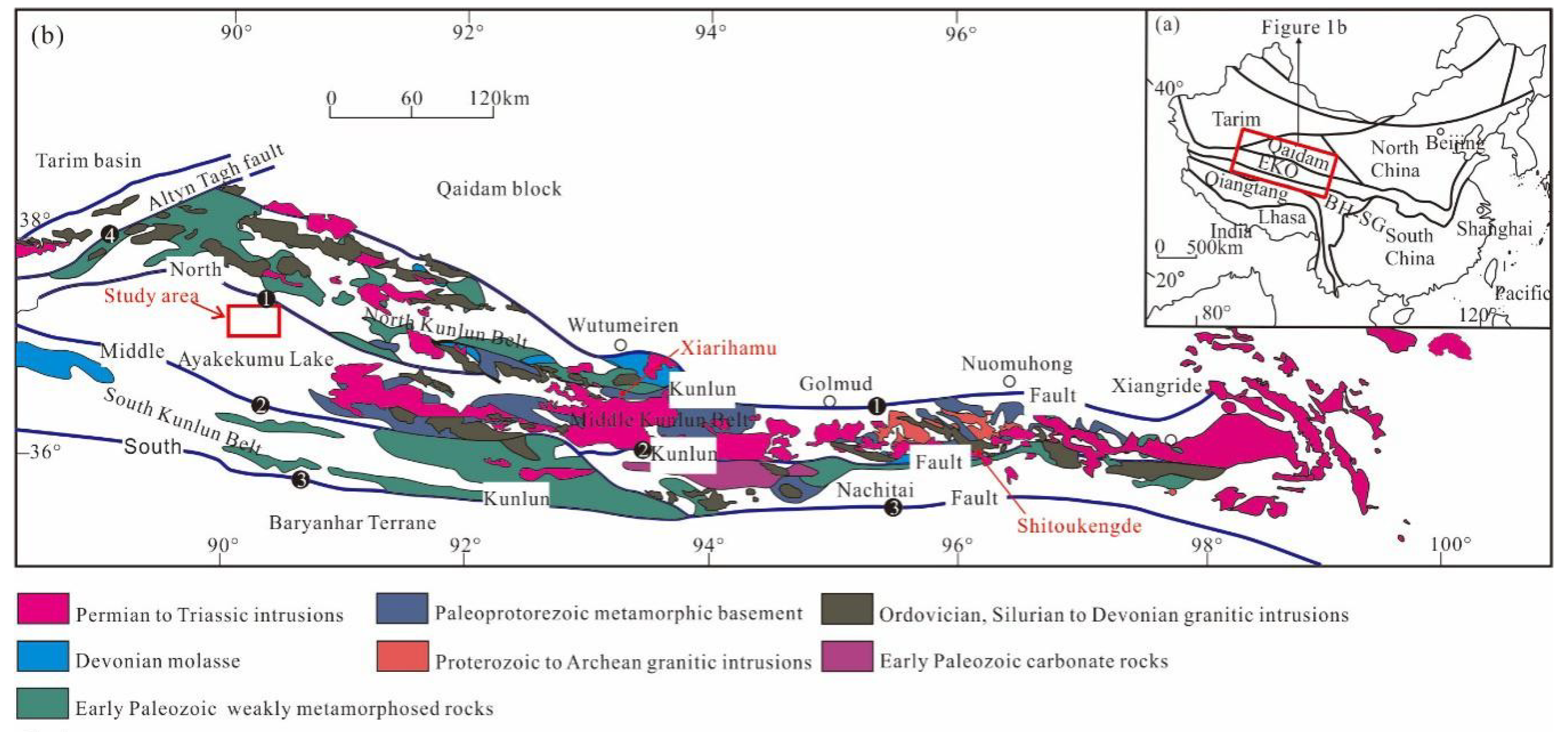
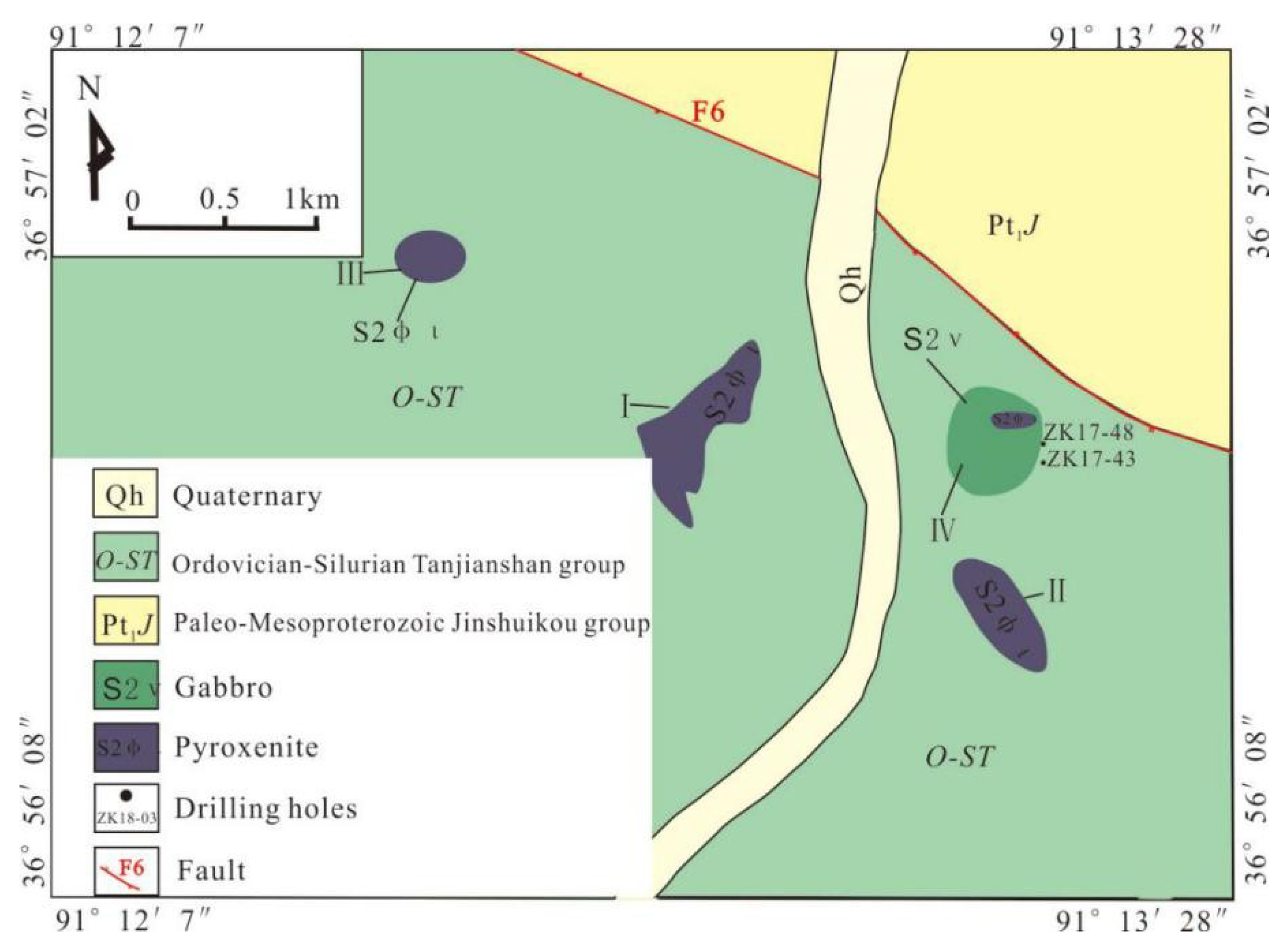
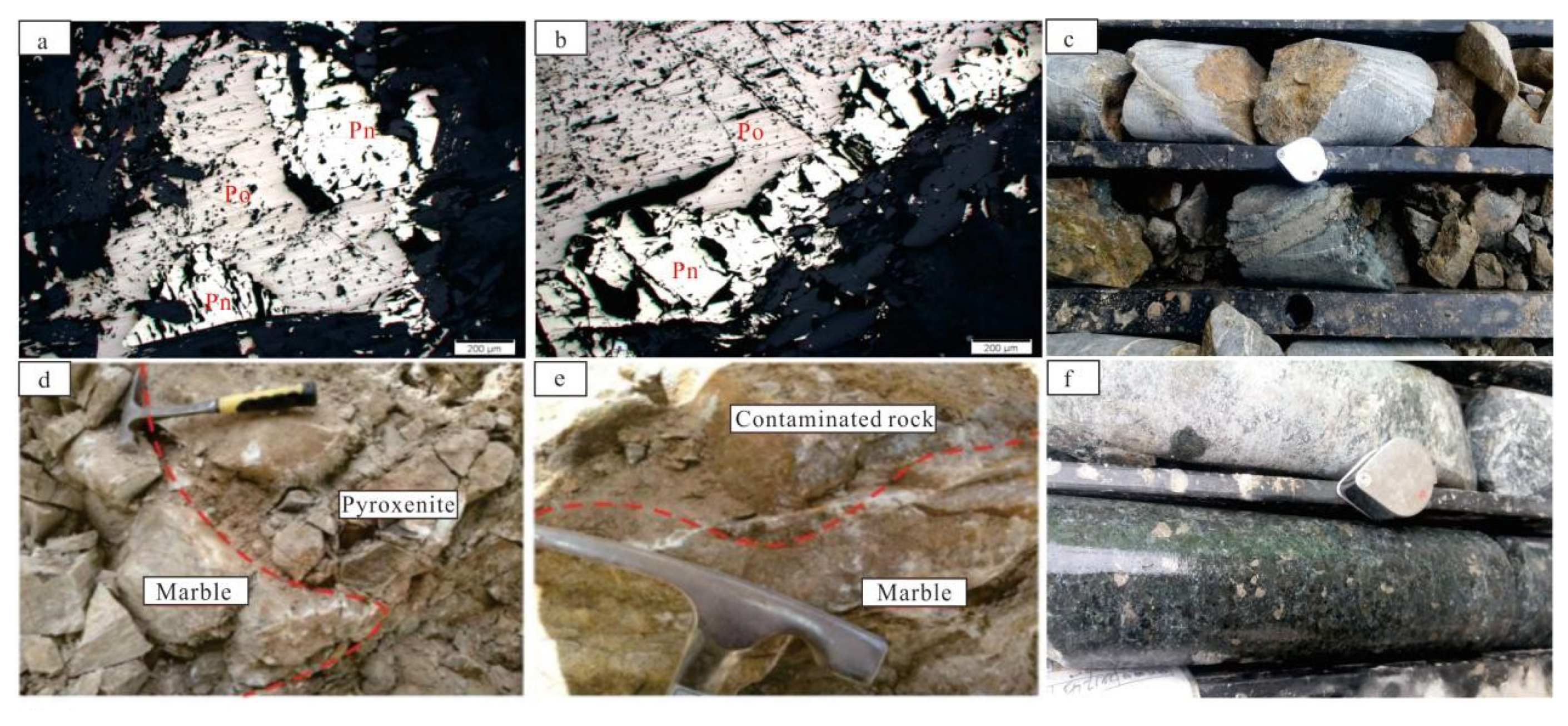
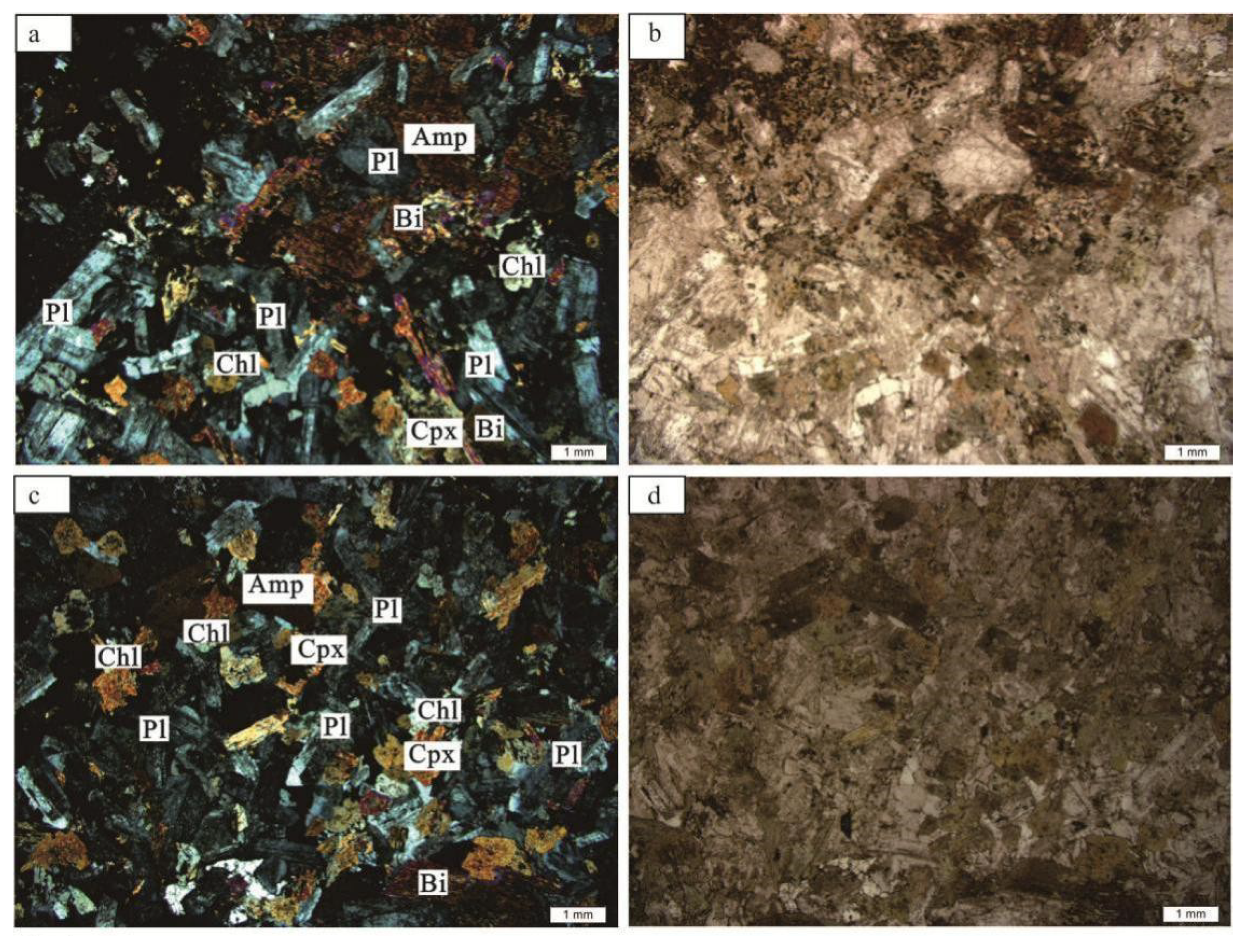
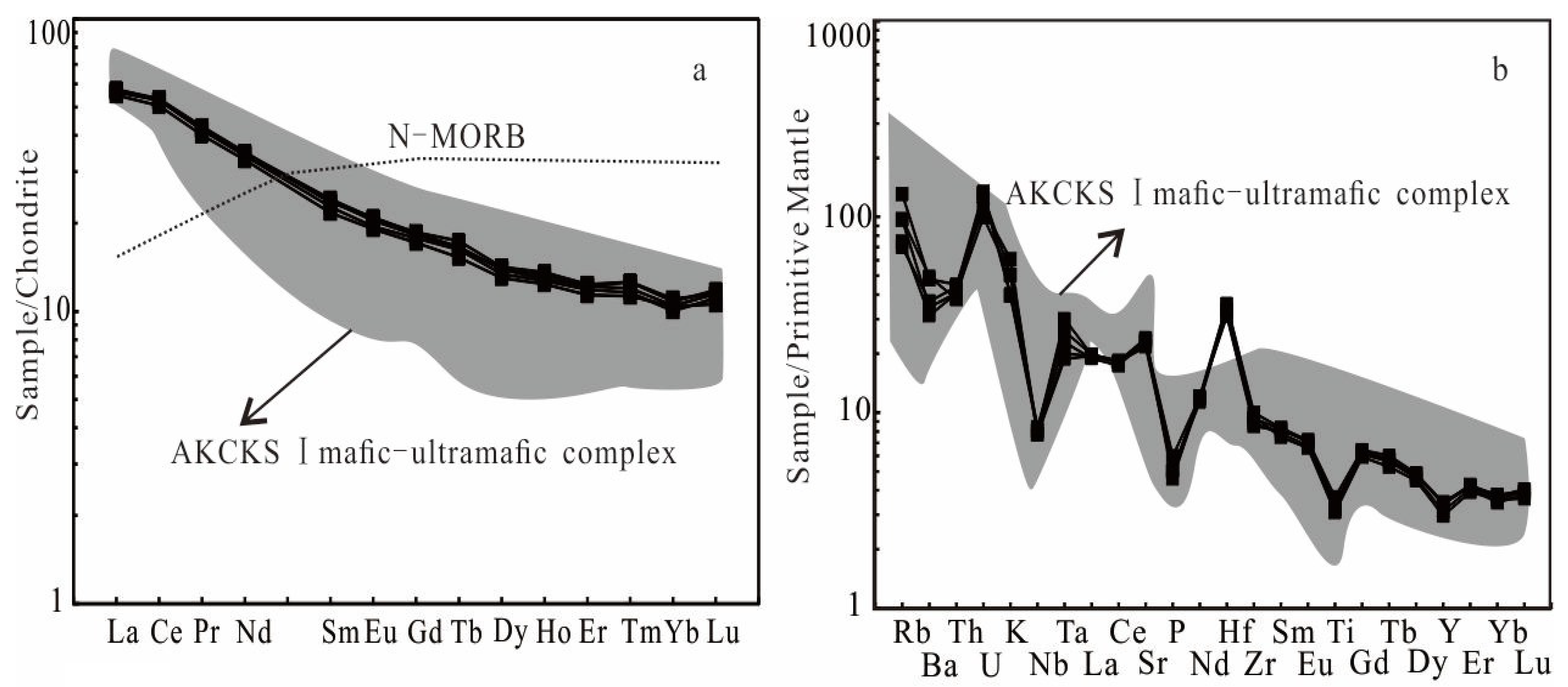
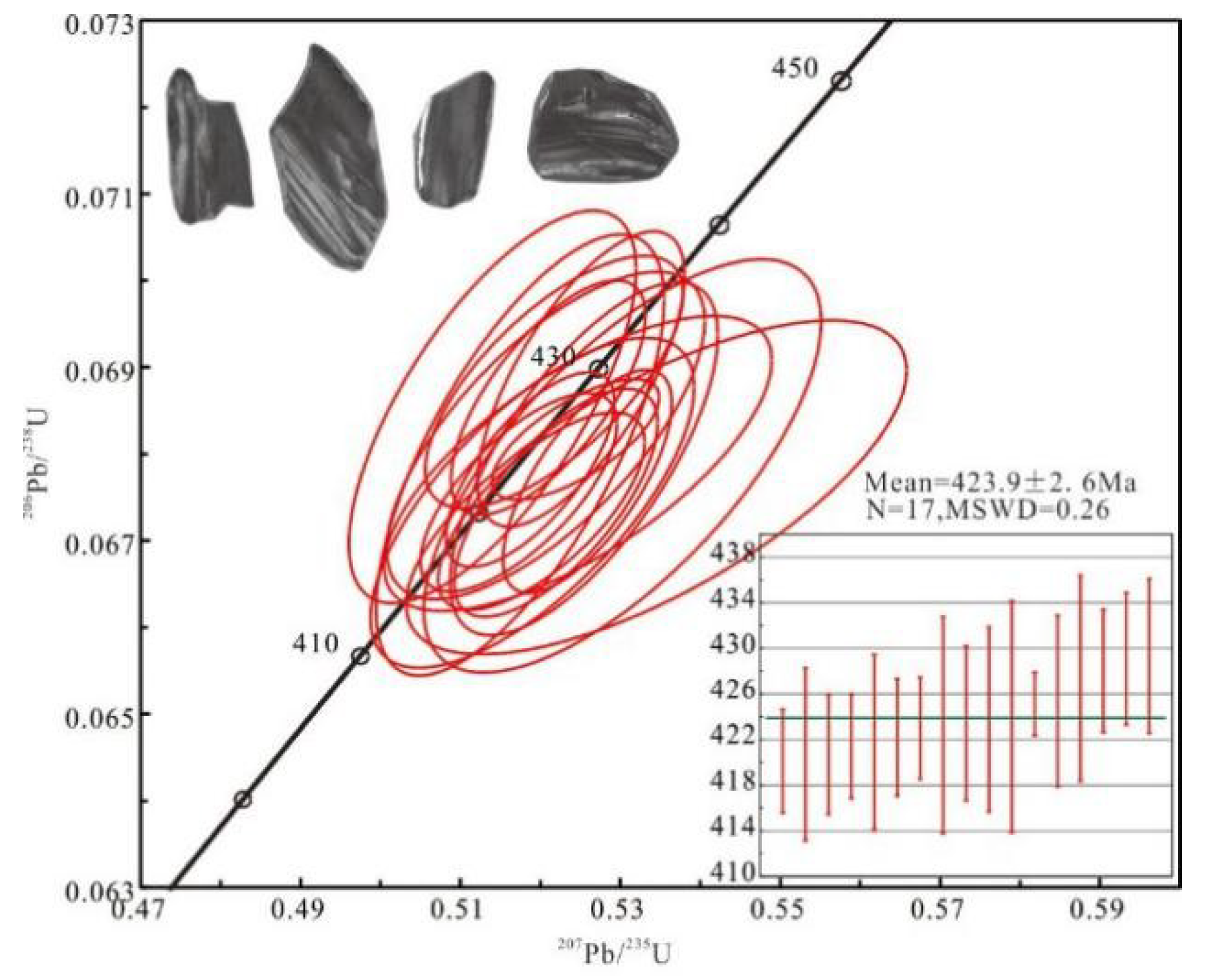
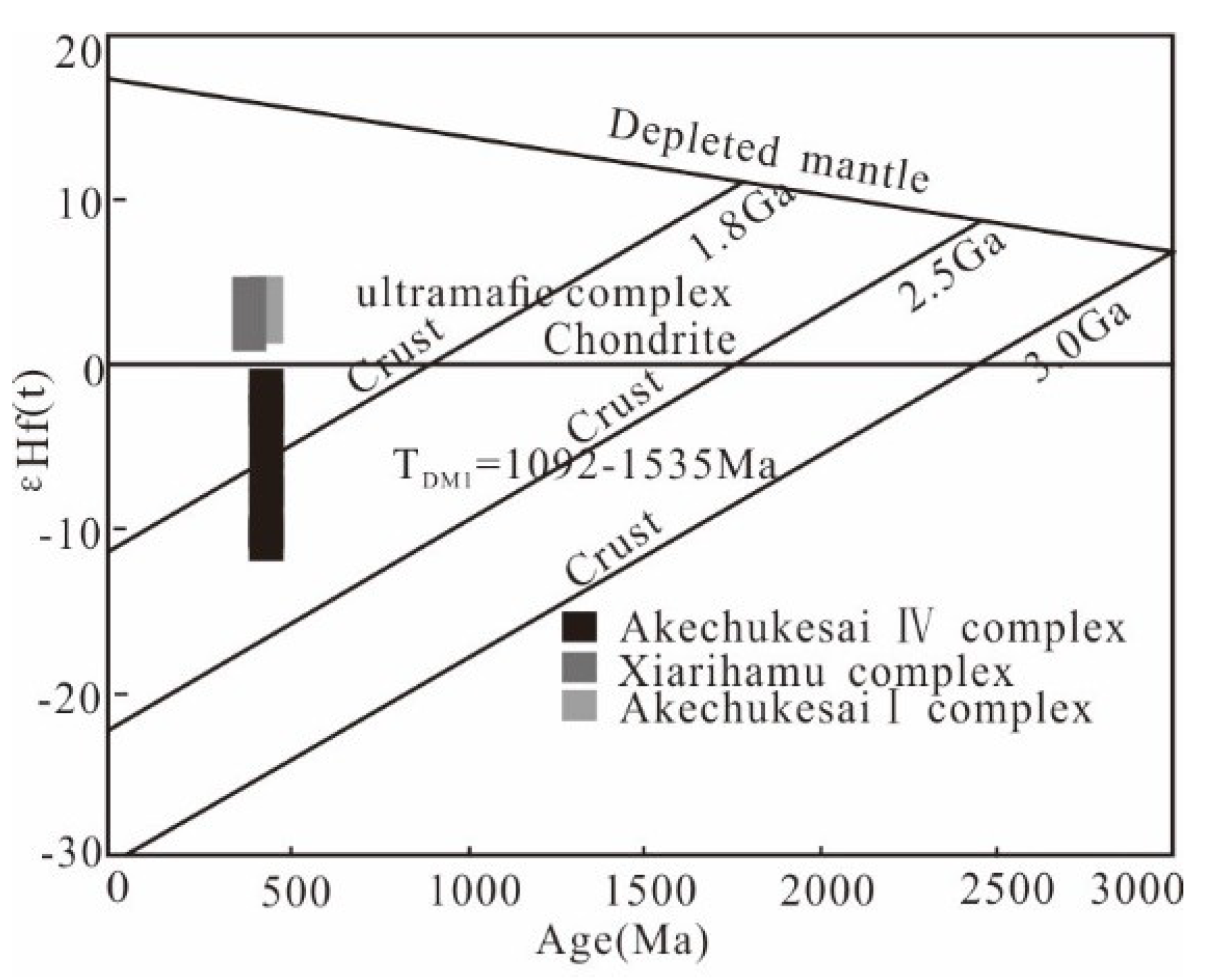
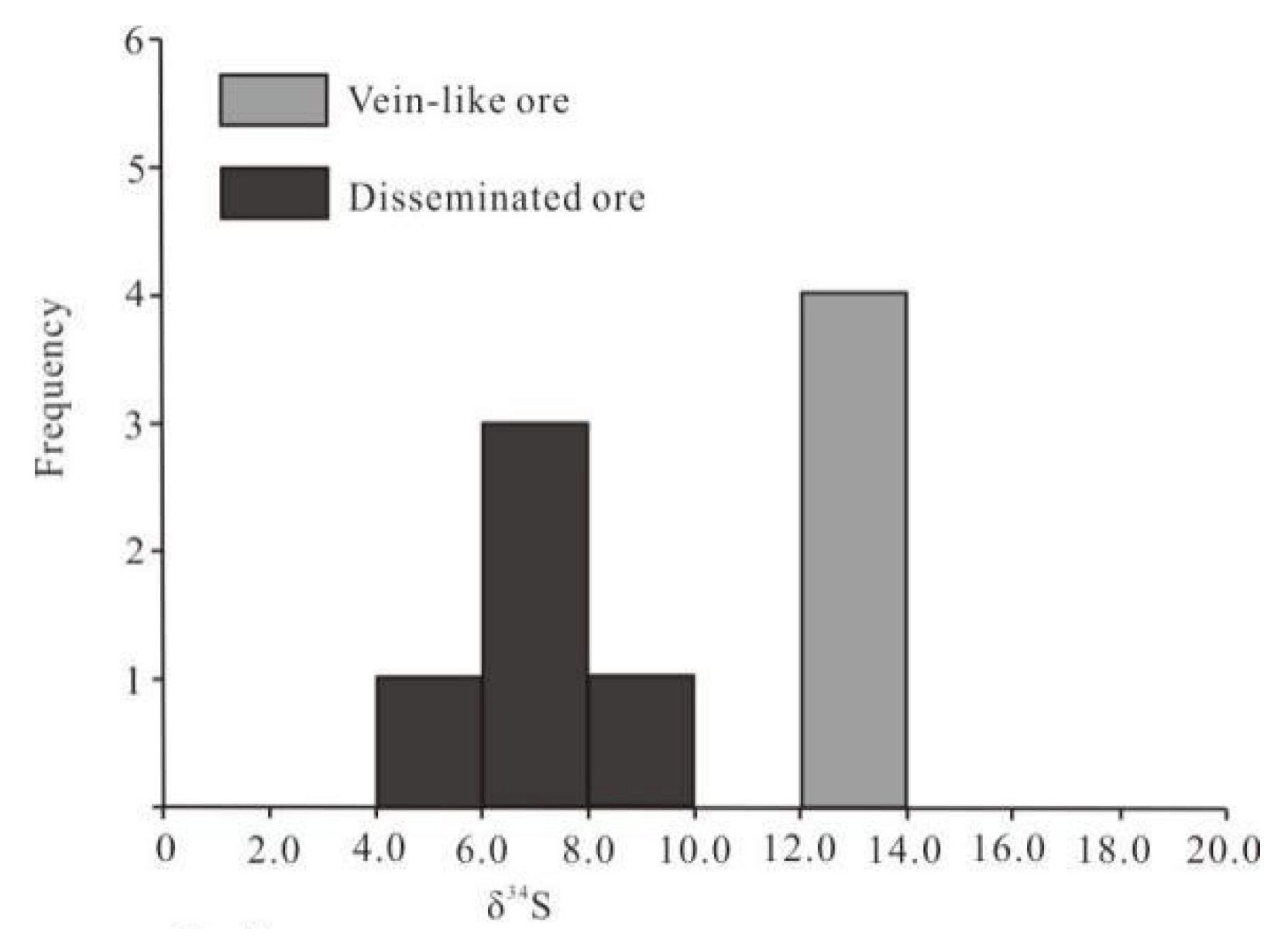
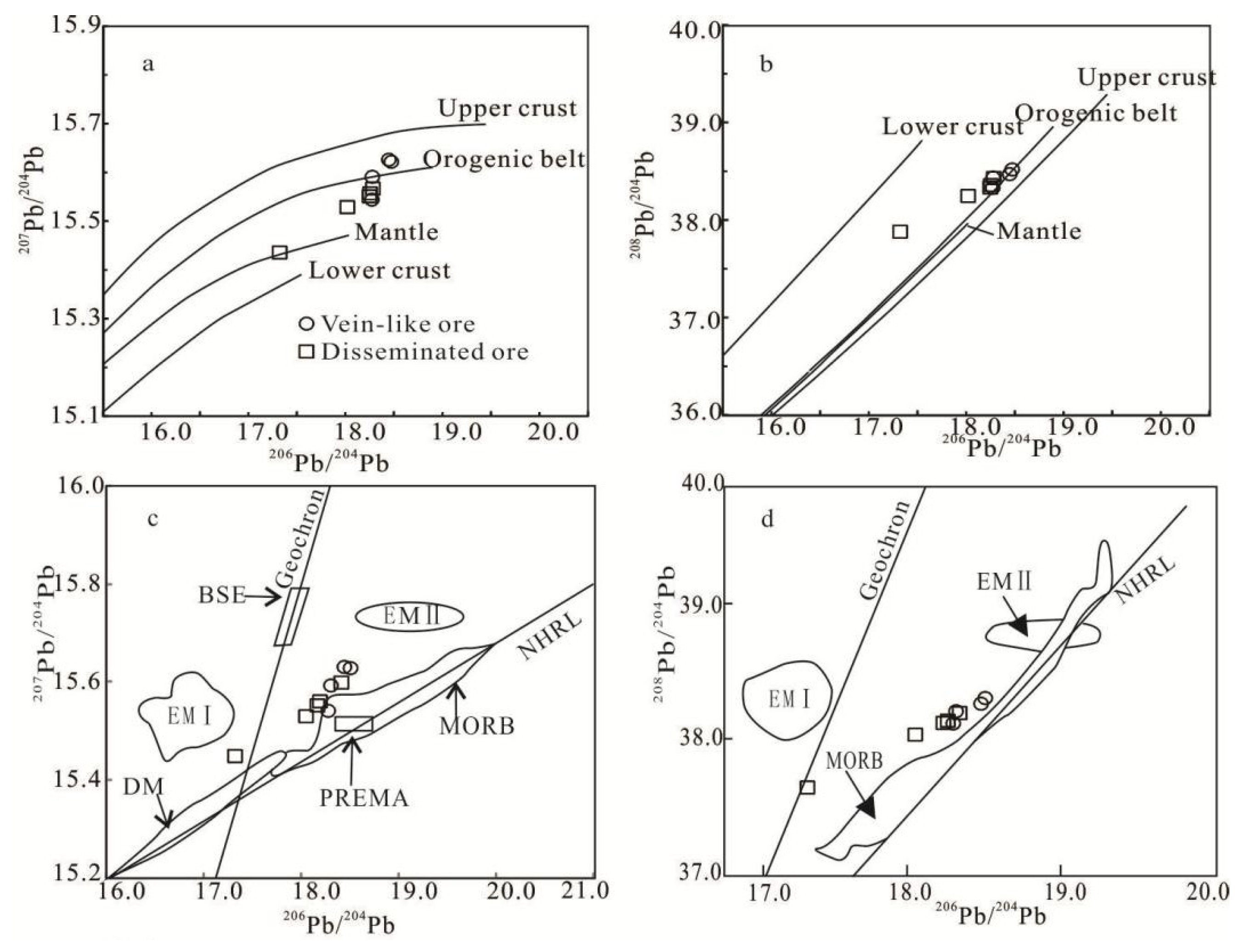
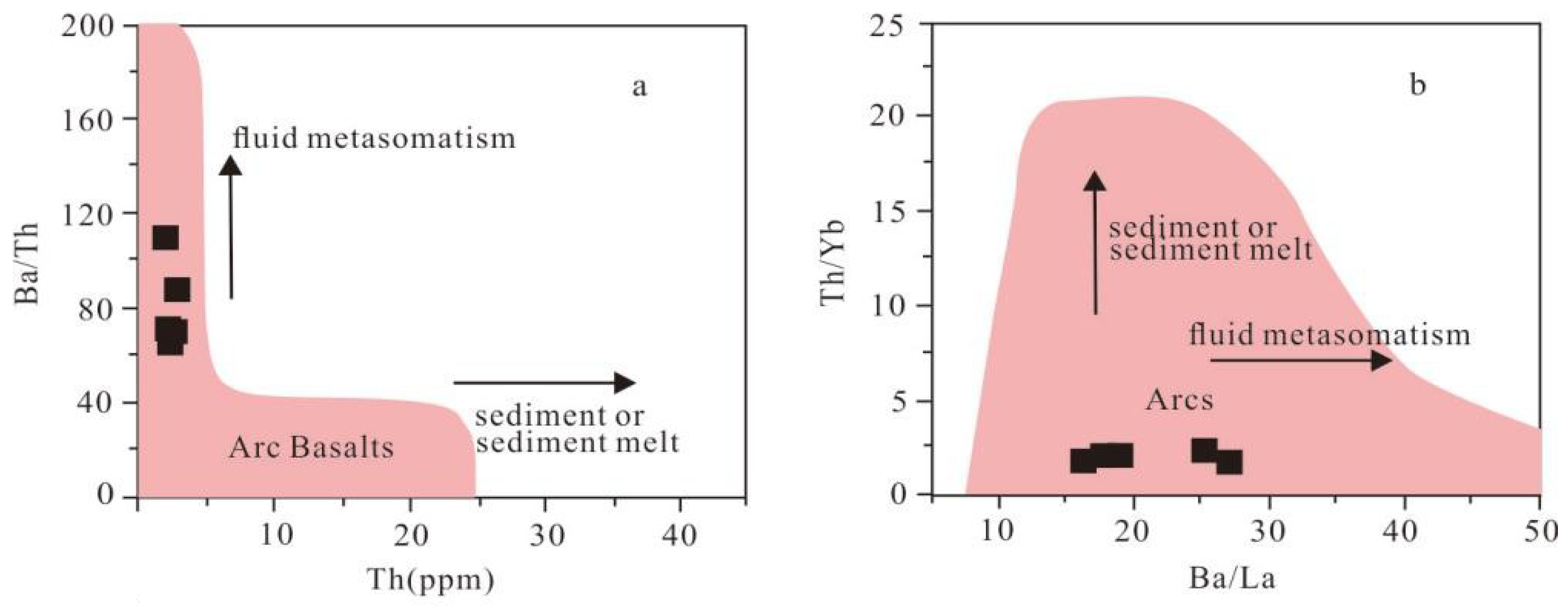
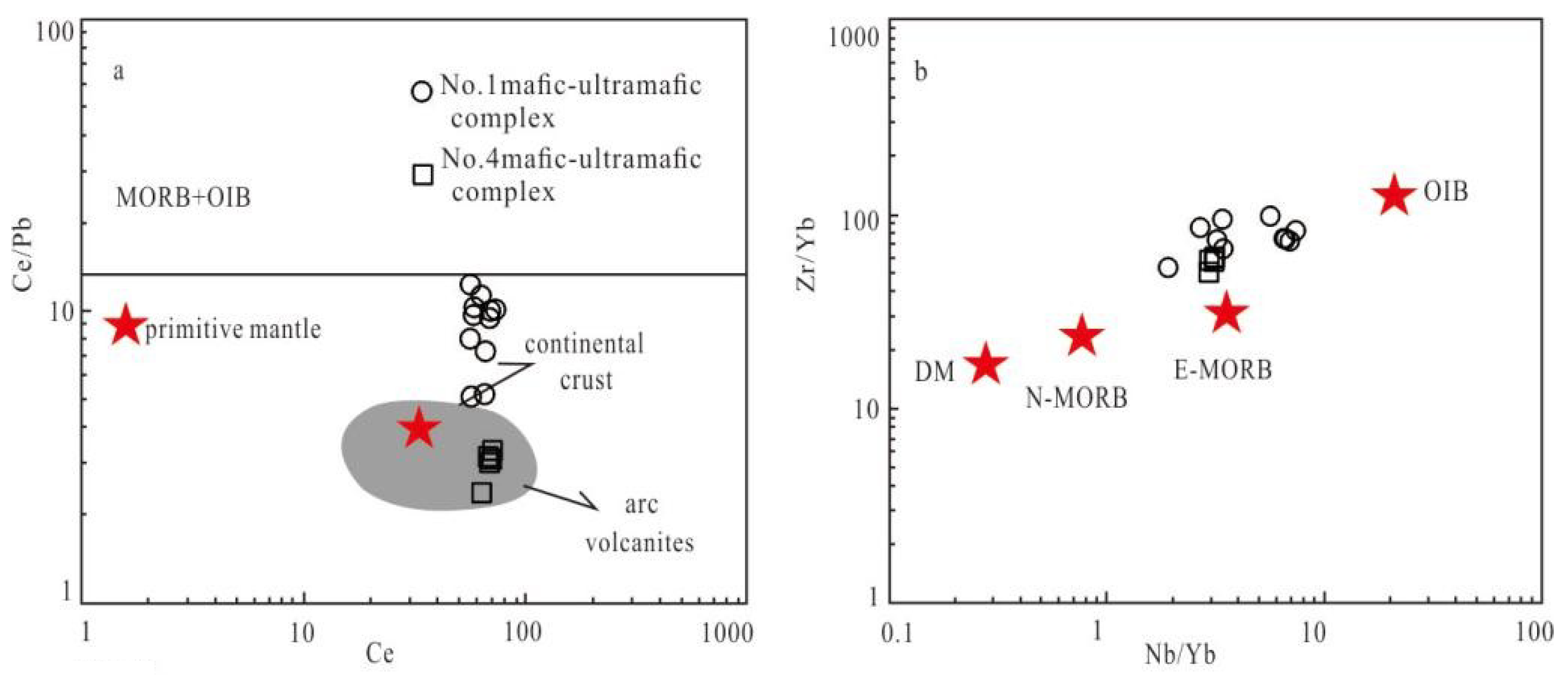
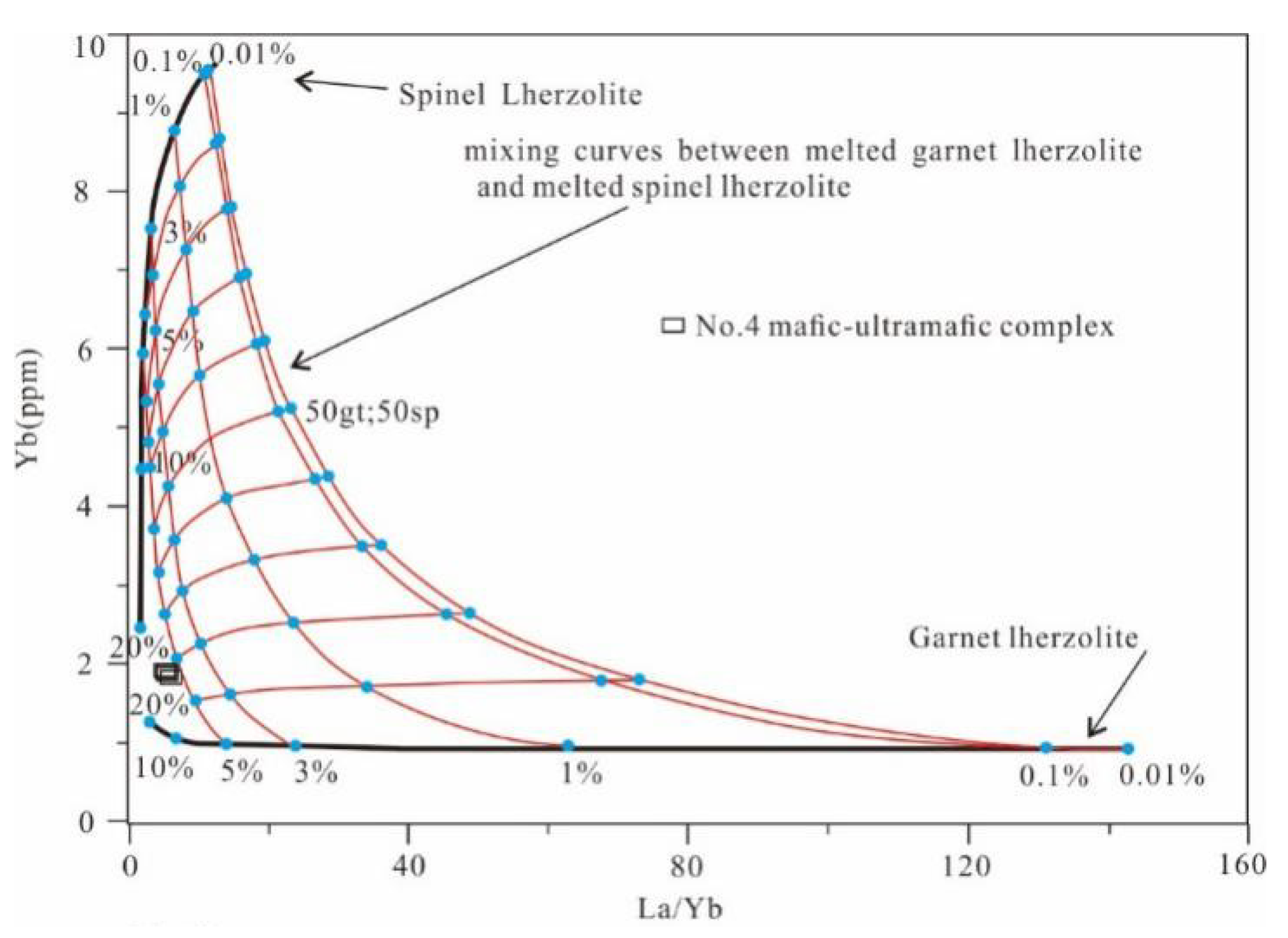
| Sample | AKC-IV | AKC-IV | AKC-IV | AKC-IV | AKC-IV |
|---|---|---|---|---|---|
| Y1 | Y2 | Y3 | Y4 | Y5 | |
| SiO2 | 53.33 | 53.2 | 53.78 | 53.75 | 53.72 |
| Al2O3 | 18.25 | 17.93 | 17.88 | 18.04 | 18.19 |
| CaO | 9.01 | 8.7 | 8.8 | 7.86 | 8.03 |
| Fe2O3 | 1.81 | 1.56 | 0.99 | 2.17 | 2.03 |
| FeO | 3.64 | 4.06 | 4.28 | 3.13 | 3.31 |
| K2O | 1.19 | 1.21 | 1.53 | 1.51 | 1.83 |
| MgO | 6.31 | 6.28 | 6.22 | 6.15 | 6.17 |
| MnO | 0.1 | 0.12 | 0.12 | 0.11 | 0.09 |
| Na2O | 3.01 | 3.03 | 2.96 | 3.79 | 3.01 |
| P2O5 | 0.11 | 0.13 | 0.11 | 0.11 | 0.1 |
| TiO2 | 0.7 | 0.8 | 0.67 | 0.7 | 0.74 |
| LOI | 2.41 | 2.71 | 2.36 | 2.38 | 2.44 |
| Total | 99.86 | 99.73 | 99.69 | 99.71 | 99.68 |
| Mg# | 68.12 | 67.22 | 68.22 | 68.34 | 68.18 |
| M/F | 0.91 | 0.87 | 0.91 | 0.92 | 0.92 |
| La | 13.56 | 13.63 | 13.01 | 13.37 | 13.36 |
| Ce | 32.67 | 32.28 | 30.91 | 32.23 | 32.35 |
| Pr | 4.07 | 3.99 | 3.81 | 3.96 | 3.97 |
| Nd | 16.35 | 16.27 | 15.38 | 15.9 | 16.1 |
| Sm | 3.6 | 3.7 | 3.33 | 3.48 | 3.65 |
| Eu | 1.22 | 1.21 | 1.11 | 1.13 | 1.19 |
| Gd | 3.79 | 3.83 | 3.53 | 3.65 | 3.74 |
| Tb | 0.62 | 0.65 | 0.57 | 0.61 | 0.62 |
| Dy | 3.53 | 3.6 | 3.31 | 3.41 | 3.53 |
| Ho | 0.75 | 0.77 | 0.7 | 0.72 | 0.73 |
| Er | 2.01 | 2.05 | 1.88 | 1.96 | 2.01 |
| Tm | 0.32 | 0.32 | 0.29 | 0.3 | 0.31 |
| Yb | 1.88 | 1.84 | 1.77 | 1.71 | 1.78 |
| Lu | 0.29 | 0.3 | 0.27 | 0.28 | 0.29 |
| Hf | 9.62 | 11.08 | 10.38 | 10.18 | 10.39 |
| Nb | 5.76 | 6.01 | 5.77 | 5.54 | 5.5 |
| Ta | 1.23 | 1.06 | 0.94 | 0.82 | 0.77 |
| W | 14 | 15.88 | 16.15 | 13.7 | 22.69 |
| Tl | 0.36 | 0.36 | 0.5 | 0.49 | 0.6 |
| Pb | 14.37 | 13.77 | 17.22 | 13.01 | 13.5 |
| Bi | 0.18 | 0.24 | 0.24 | 0.22 | 0.17 |
| Th | 3.46 | 3.73 | 3.22 | 3.45 | 3.82 |
| U | 2.74 | 2.82 | 2.67 | 2.09 | 2.3 |
| Sc | 6.05 | 6.68 | 4.7 | 5.65 | 7.59 |
| Ti | 4332 | 4775 | 4123 | 4273 | 4426 |
| V | 137 | 143.4 | 128.2 | 132.2 | 135.5 |
| Cr | 14.59 | 11.71 | 13.13 | 11.94 | 11.25 |
| Mn | 842 | 956.6 | 968.8 | 861.9 | 759.1 |
| Co | 31.5 | 32.37 | 27.64 | 30.13 | 30.19 |
| Ni | 46.32 | 40.64 | 38.19 | 46.6 | 44.47 |
| Cu | 20.68 | 17.79 | 20.62 | 24.97 | 19.89 |
| Zn | 70.6 | 73.05 | 66.39 | 68.77 | 75.9 |
| Ga | 16.94 | 17.26 | 16.58 | 16.15 | 16.21 |
| As | 7.97 | 3.48 | 3.6 | 4.33 | 8.68 |
| Rb | 47.45 | 44.43 | 61.91 | 61.21 | 82.87 |
| Sr | 499.5 | 490 | 490.5 | 459.1 | 506.9 |
| Y | 15.46 | 15.61 | 13.47 | 14.23 | 15.85 |
| Zr | 95.34 | 111.6 | 106.4 | 98.71 | 104.2 |
| Cd | 1.34 | 1.39 | 1.46 | 1.34 | 1.54 |
| Sb | 5.35 | 5.41 | 5.33 | 5.07 | 5.38 |
| Cs | 7.26 | 6.21 | 6.03 | 7.44 | 7.64 |
| Ba | 219.1 | 258.4 | 345.5 | 241.5 | 334.9 |
| ΣREE | 84.67 | 84.42 | 79.85 | 82.71 | 83.62 |
| (La/Yb)N | 4.88 | 5.01 | 4.96 | 5.28 | 5.07 |
| (La/Sm)N | 3.51 | 3.43 | 3.65 | 3.58 | 3.42 |
| (Gd/Yb)N | 1.63 | 1.68 | 1.61 | 1.73 | 1.7 |
| Eu/Eu* | 1 | 0.97 | 0.98 | 0.96 | 0.97 |
| No. | Content (pm) | Th/U | Isotopic Ratios | Age (Ma) | |||||||||||
|---|---|---|---|---|---|---|---|---|---|---|---|---|---|---|---|
| U | Th | 207Pb/206Pb | 1 σ | 207Pb/235U | 1 σ | 206Pb/238U | 1 σ | 207Pb/206Pb | 1 σ | 207Pb/235U | 1 σ | 206Pb/238U | 1 σ | ||
| 1 | 2042 | 1491 | 0.73 | 0.0559 | 0.0006 | 0.5201 | 0.0085 | 0.0673 | 0.0008 | 447 | 23 | 425 | 6 | 420 | 5 |
| 2 | 1758 | 754 | 0.43 | 0.0558 | 0.0012 | 0.5190 | 0.0134 | 0.0674 | 0.0013 | 445 | 48 | 424 | 9 | 421 | 8 |
| 3 | 3421 | 1566 | 0.46 | 0.0559 | 0.0005 | 0.5219 | 0.0084 | 0.0674 | 0.0009 | 450 | 21 | 426 | 6 | 421 | 5 |
| 4 | 1075 | 456 | 0.42 | 0.0554 | 0.0006 | 0.5173 | 0.0081 | 0.0676 | 0.0008 | 428 | 24 | 423 | 5 | 421 | 5 |
| 5 | 599 | 218 | 0.36 | 0.0571 | 0.0018 | 0.5345 | 0.0207 | 0.0676 | 0.0013 | 494 | 68 | 435 | 14 | 422 | 8 |
| 6 | 2577 | 1568 | 0.61 | 0.0561 | 0.0006 | 0.5259 | 0.0070 | 0.0677 | 0.0008 | 456 | 22 | 429 | 5 | 422 | 5 |
| 7 | 1951 | 787 | 0.40 | 0.0555 | 0.0010 | 0.5187 | 0.0070 | 0.0678 | 0.0007 | 431 | 39 | 424 | 5 | 423 | 4 |
| 8 | 2059 | 1313 | 0.64 | 0.0565 | 0.0011 | 0.5303 | 0.0164 | 0.0679 | 0.0016 | 471 | 42 | 432 | 11 | 423 | 9 |
| 9 | 3051 | 1286 | 0.42 | 0.0559 | 0.0018 | 0.5247 | 0.0160 | 0.0679 | 0.0011 | 446 | 73 | 428 | 11 | 423 | 7 |
| 10 | 1483 | 596 | 0.40 | 0.0561 | 0.0006 | 0.5254 | 0.0111 | 0.0679 | 0.0013 | 456 | 25 | 429 | 7 | 424 | 8 |
| 11 | 1200 | 733 | 0.61 | 0.0556 | 0.0015 | 0.5174 | 0.0119 | 0.0680 | 0.0017 | 436 | 61 | 423 | 8 | 424 | 10 |
| 12 | 533 | 176 | 0.33 | 0.0557 | 0.0007 | 0.5244 | 0.0069 | 0.0682 | 0.0005 | 440 | 30 | 428 | 5 | 425 | 3 |
| 13 | 1276 | 571 | 0.45 | 0.0554 | 0.0012 | 0.5207 | 0.0131 | 0.0682 | 0.0012 | 430 | 49 | 426 | 9 | 425 | 8 |
| 14 | 1617 | 920 | 0.57 | 0.0542 | 0.0008 | 0.5140 | 0.0119 | 0.0685 | 0.0015 | 380 | 31 | 421 | 8 | 427 | 9 |
| 15 | 2813 | 1440 | 0.51 | 0.0549 | 0.0005 | 0.5210 | 0.0080 | 0.0686 | 0.0009 | 407 | 19 | 426 | 5 | 428 | 5 |
| 16 | 3280 | 1617 | 0.49 | 0.0548 | 0.0008 | 0.5217 | 0.0107 | 0.0688 | 0.0010 | 403 | 34 | 426 | 7 | 429 | 6 |
| 17 | 1940 | 632 | 0.33 | 0.0553 | 0.0008 | 0.5251 | 0.0085 | 0.0689 | 0.0011 | 422 | 30 | 429 | 6 | 429 | 7 |
| No. | Age (Ma) | 176Hf/177Hf | 1σ | 176Lu/177Hf | 1σ | 176Yb/177Hf | 1σ | εHf(0) | 1σ | εHf(t) | 1σ | TDM1 | TDM2 | fLu/Hf |
|---|---|---|---|---|---|---|---|---|---|---|---|---|---|---|
| 1 | 424 | 0.282210 | 0.000014 | 0.002621 | 0.000008 | 0.066342 | 0.000314 | −19.9 | 0.7 | −11.3 | 0.7 | 1535 | 1907 | −0.92 |
| 2 | 424 | 0.282483 | 0.000015 | 0.001150 | 0.000004 | 0.029024 | 0.000076 | −10.2 | 0.7 | −1.2 | 0.8 | 1092 | 1352 | −0.97 |
| 3 | 424 | 0.282232 | 0.000015 | 0.002144 | 0.000017 | 0.056160 | 0.000437 | −19.1 | 0.7 | −10.4 | 0.8 | 1483 | 1856 | −0.94 |
| 4 | 424 | 0.282436 | 0.000014 | 0.000952 | 0.000022 | 0.023045 | 0.000871 | −11.9 | 0.7 | −2.8 | 0.7 | 1152 | 1441 | −0.97 |
| 5 | 424 | 0.282320 | 0.000013 | 0.002143 | 0.000005 | 0.054055 | 0.000192 | −16.0 | 0.7 | −7.3 | 0.7 | 1357 | 1686 | −0.94 |
| 6 | 424 | 0.282459 | 0.000013 | 0.001239 | 0.000002 | 0.031064 | 0.000132 | −11.1 | 0.7 | −2.1 | 0.7 | 1128 | 1400 | −0.96 |
| 7 | 424 | 0.282414 | 0.000016 | 0.001506 | 0.000004 | 0.041224 | 0.000164 | −12.7 | 0.8 | −3.8 | 0.8 | 1200 | 1492 | −0.95 |
| 8 | 424 | 0.282434 | 0.000015 | 0.000911 | 0.000006 | 0.022934 | 0.000133 | −11.9 | 0.7 | −2.9 | 0.8 | 1153 | 1443 | −0.97 |
| 9 | 424 | 0.282288 | 0.000016 | 0.001783 | 0.000015 | 0.047849 | 0.000497 | −17.1 | 0.8 | −8.3 | 0.8 | 1389 | 1742 | −0.95 |
| 10 | 424 | 0.282448 | 0.000016 | 0.001339 | 0.000004 | 0.031726 | 0.000139 | −11.4 | 0.8 | −2.5 | 0.8 | 1146 | 1423 | −0.96 |
| 11 | 424 | 0.282234 | 0.000015 | 0.002405 | 0.000006 | 0.061395 | 0.000179 | −19.0 | 0.7 | −10.4 | 0.8 | 1491 | 1856 | −0.93 |
| 12 | 424 | 0.282371 | 0.000015 | 0.001785 | 0.000006 | 0.046687 | 0.000179 | −14.2 | 0.7 | −5.4 | 0.8 | 1271 | 1580 | −0.95 |
| 13 | 424 | 0.282239 | 0.000015 | 0.002301 | 0.000006 | 0.060993 | 0.000179 | −18.9 | 0.7 | −10.2 | 0.8 | 1480 | 1845 | −0.93 |
| 14 | 424 | 0.282313 | 0.000015 | 0.002226 | 0.000006 | 0.055819 | 0.000179 | −16.2 | 0.7 | −7.5 | 0.8 | 1370 | 1700 | −0.93 |
| Sample No. | Location | Sample | δ34S |
|---|---|---|---|
| AKC-S1 | Vein-like ore | Pyrite | 13.1 |
| AKC-S2 | Vein-like ore | Pyrite | 13.4 |
| AKC-S3 | Vein-like ore | Pyrite | 13.2 |
| AKC-S4 | Vein-like ore | Pyrite | 13.4 |
| AKC-S5 | Disseminated ore | Pyrite | 5.0 |
| AKC-S6 | Disseminated ore | Pyrrhotite | 8.5 |
| AKC-S7 | Disseminated ore | Pyrite | 7.5 |
| AKC-S8 | Disseminated ore | Pyrite | 7.2 |
| AKC-S9 | Disseminated ore | Pyrite | 7.5 |
| Sample No. | Location | Sample | 208Pb/204Pb | 207Pb/204Pb | 206Pb/204Pb |
|---|---|---|---|---|---|
| AKC-Pb1 | Vein-like ore | Pyrite | 38.116 | 15.544 | 18.272 |
| AKC-Pb2 | Vein-like ore | Pyrite | 38.233 | 15.591 | 18.276 |
| AKC-Pb3 | Vein-like ore | Pyrite | 38.272 | 15.626 | 18.447 |
| AKC-Pb4 | Vein-like ore | Pyrite | 38.327 | 15.622 | 18.472 |
| AKC-Pb5 | Disseminated ore | Pyrite | 38.147 | 15.557 | 18.254 |
| AKC-Pb6 | Disseminated ore | Pyrrhotite | 38.119 | 15.551 | 18.247 |
| AKC-Pb7 | Disseminated ore | Pyrite | 38.227 | 15.567 | 18.284 |
| AKC-Pb8 | Disseminated ore | Pyrite | 38.021 | 15.529 | 18.019 |
| AKC-Pb9 | Disseminated ore | Pyrite | 37.610 | 15.422 | 17.323 |
© 2019 by the authors. Licensee MDPI, Basel, Switzerland. This article is an open access article distributed under the terms and conditions of the Creative Commons Attribution (CC BY) license (http://creativecommons.org/licenses/by/4.0/).
Share and Cite
Yan, J.; Sun, F.; Qian, Y.; Li, L.; Zhang, Y.; Yan, Z. Geochemistry, Geochronology, and Hf-S-Pb Isotopes of the Akechukesai IV Mafic-Ultramafic Complex, Western China. Minerals 2019, 9, 275. https://doi.org/10.3390/min9050275
Yan J, Sun F, Qian Y, Li L, Zhang Y, Yan Z. Geochemistry, Geochronology, and Hf-S-Pb Isotopes of the Akechukesai IV Mafic-Ultramafic Complex, Western China. Minerals. 2019; 9(5):275. https://doi.org/10.3390/min9050275
Chicago/Turabian StyleYan, Jiaming, Fengyue Sun, Ye Qian, Liang Li, Yongsheng Zhang, and Zhengping Yan. 2019. "Geochemistry, Geochronology, and Hf-S-Pb Isotopes of the Akechukesai IV Mafic-Ultramafic Complex, Western China" Minerals 9, no. 5: 275. https://doi.org/10.3390/min9050275
APA StyleYan, J., Sun, F., Qian, Y., Li, L., Zhang, Y., & Yan, Z. (2019). Geochemistry, Geochronology, and Hf-S-Pb Isotopes of the Akechukesai IV Mafic-Ultramafic Complex, Western China. Minerals, 9(5), 275. https://doi.org/10.3390/min9050275




